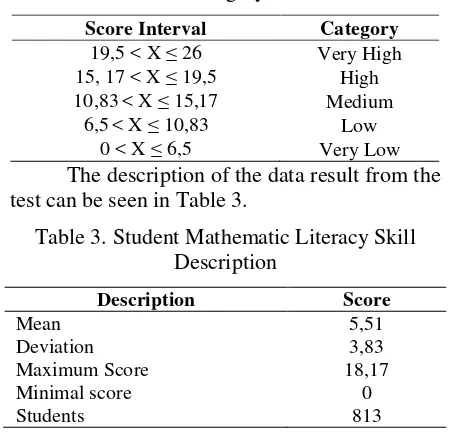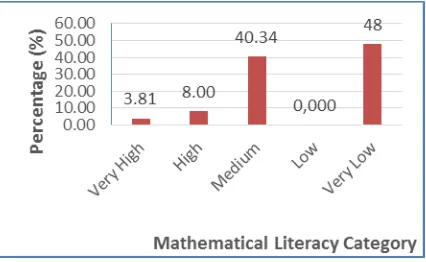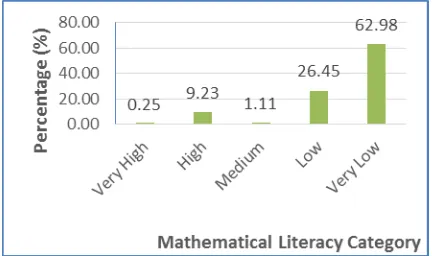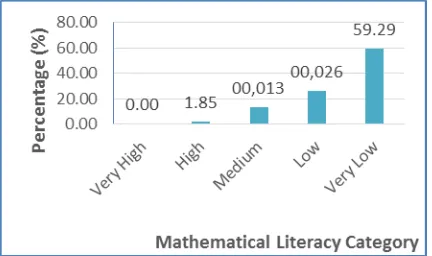Mathematical Literacy of Senior High School Students in Yogyakarta
Rosalia Hera Novita Sari 1 *, Ariyadi Wijaya 2
1, 2
Department of Mathematics Education, Graduate School of Universitas Negeri Yogyakarta. Jalan Colombo No. 1, Karangmalang, Yogyakarta 55281, Indonesia
* Corresponding Author. Email: rosalia.hera@yahoo.co.id
Received: 26 August 2016; Revised: 17 May 2017; Accepted: 18 May 2017
Abstract
The aim of this research is to describe mathematical literacy of Senior High School students in Yogyakarta. This research was a survey using quantitative design. The population was all of Senior High School students in Yogyakarta. The sampling was a combination of stratified random sampling and cluster random sampling. The sample was 813 students the 10th grade of Senior High School. These schools include high, average and low category based on the score in the national examination of mathematics subject. The data collection was by a test. The student was tested with 13 items of mathematical literacy problems. The analysis of those data used descriptive statistics including mean, standard deviation, maximum and minimum score, total score, and also test statistics z ( ). The research finding reveals that mathematical literacy of Senior High School students in Yogyakarta is in a very low category. Mathematical literacy of Senior High School students for understanding indicator belong to low category and for the other indicators of process belongs to very a low category. Keywords: mathematical literacy
How to Cite: Sari, R., & Wijaya, A. (2017). Mathematical literacy of senior high school students in
Yogyakarta. Jurnal Riset Pendidikan Matematika, 4(1), 100-107.
doi:http://dx.doi.org/10.21831/jrpm.v4i1.10649
Permalink/DOI: http://dx.doi.org/10.21831/jrpm.v4i1.10649
__________________________________________________________________________________________
INTRODUCTION
In this globalization era, that needed peoples who had the capability to find new concepts, to open network and competence able to fulfill high jobs standard (Hayat & Yusuf, 2010, p. 5). The required societies present days is not only they who capable who understand particularly sciences but also deeper. Right now, the society demand to using the knowledge optimally to become smart and critically to resist and process information. It is important to support complexity problem-solving.
Education has an important role to face that challenges. Education was a means to prevent risks and tools that can help increase human quality life in continuities (Moretti & Frandell, 2013, p. 1). So that, education demand to develop creative thinking, flexible, problem-solving, collaboration skill and innovation of students that needed to success in jobs and life. (Pacific Policy Research Center, 2010, p. 1). Education demand to supply student competence to apply the knowledge in daily life.
The urgently of knowledge application in daily life create Organization for Economic
Co-operation and Development (OECD) to held
Program for International Student Assessment
(PISA). One of the focus that examined in PISA
was mathematical literacy. Mathematical literacy in PISA means an individual’s capacity to formulate, employ, and interpret mathematics in a variety of contexts. It includes reasoning mathematically and using mathematical con-cepts, procedures, facts and tools to describe, explain and predict phenomena. It assists indi-viduals to recognize the role that mathematics plays in the world and to make the well-founded judgments and decisions needed by constructive, engaged and reflective citizens (Organisation for Economic Co-operation and Development, 2013, p. 25).
exploring, connecting and reasoning also using variety mathematical methods (Stacey & Turner, 2015, p. 12). Simplicity, Ojose (2011, p. 90) say that mathematic literacy was the knowledge to know and apply basic mathematics in our every day living. Fit out opinion before, Steen, Turner, & Burkhardt (2007, p. 286) add word effectively in the definition of mathematic literacy. Mathe-matic literacy defined as a competence to use mathematical knowledge and comprehension effectively to face daily life challenges.
That opinions emphasize on the same thing that was how to use mathematic to solve daily problems better and effectively. The use of the knowledge here through some process start from exploring, connecting, formulating, deter-mining, reasoning and the other mathematical thinking process. That thinking process can be reduce to three prior process that was for-mulating, using, and interpreting. Mathematical literacy can be definite as a competency to formulating, using, and interpreting mathematic in variety problem-solving context in daily life effectively.
Mathematical literacy can drive someone to considerate and understand the use of mathematics in daily life. That will helpful to think numerically and spatially in order to interpret and critically analyze everyday situations confidently (Department of Education Republic of South Africa, 2003, p. 9). Numerical and spatial thinking in interpretation and critical analysis will needed in daily life. For the example in politics, people who had good mathematical can changes the statistic data to become a kuantitatif fact and effective infor-mation to choose a legislation wiser (Cohen, Manion, & Morrison, 2007). Not only that, simple thing such as determine nearest way or to estimate expense can also helped by the mathematic literacy.
The important of mathematic literacy also paid attention by the Indonesian government in here Education and Culture Ministry (Kem-dikbud) that showed from the participation of Indonesia in PISA. Another that, its also can be seen in the competency and aims of learning that encapsulated in curriculum. In the newest curri-culum, national curriculum as example, mathe-matic literacy reflected in main competency domain knowledge and skills mathematics teaching (Menteri Pendidikan dan Kebudayaan Republik Indonesia, 2016). In that main competency, mathematics as one of the required subject expected not only to supply student with
knowledge to use calculation or formula to solve an examination but also to involve reasoning and analytical thinking to solve daily problem or mathematic literacy skill. This purpose hope-fully can developed optimally when students get a formal education. In another word hopefully students mathematic literacy skill have improve optimally with obtain mathematics knowledge from formal education path completely.
In Indonesian formal education, mathe-matics became a require subject until senior high school. As the last stage of formal mathematics education for all student hopefully senior high school student had mathematic literacy skills. That skill not just needed by students that will continued to the next stage that related with mathematics and sciences but also all student considering the use. Seen from the cognitive development, senior high school student can think abstract and logic (Slavin, 2014, pp. 39– 41). This development suitable and support mathematic literacy skill so student of senior high school expected to had that skill.
However, the assessment system in Indonesian not yet occur students mathematic literacy skill specifically. The systems that used is National examinations (UN) which the problems still in low level of student cognitive aspect (Kamaliyah, Zulkardi, & Darmawijoyo, 2013, p. 9). The problems not yet can reveals student mathematical literacy skill that include in high level cognitive aspect.
All this time students mathematical literacy skills only seen from the survey that held by PISA. This survey analysis that used cover tree domain: process, content and context. Process domain consist of student ability to connect the problems context with math and also solve it. Then, content and context cover the mathematic content that tested. The survey re-sult show that mathematic literacy of Indonesian students still low that is 64th from 65 participant. Almost of them only can solve problem below 2nd level (Organisation for Economic Co-operation and Development, 2014, pp. 66–69). Its show that Indonesian students mathematic literacy skill still low.
students has a good mathematic literacy skill so can become models to correct the curriculum. Without pre-mapping that process less than optimal.
That mapping has been already initiate by Education and Culture Minister in the research about mathematic literacy skill for student of elementary and secondary school at 2013.the
result doesn’t far different from PISA result
was students mathematic literacy skill still low (Mahdiansyah & Rahmawati, 2014). The research take seven province in Indonesian witch one of them was Daerah Istimewa
component of mathematic literacy doesn’t
analyses deeply. It underline the needed of student mathematic literacy skill mapping reviewed from process domain.
Process domain was the process that happened when student solve real problems. There are two term that used to describe that process. They are mathematical process (Niss, 2010; Organisation for Economic & Co-operation and Development, 2003) and modeling process (Blum & Ferri, 2009; Henning & Keune, 2007). Mathematical process consist of formulating, using, interpreting, and evaluating (Organisation for Economic & Co-operation and Development, 2003, pp. 38–39). Meanwhile, modeling process can be simplify into tree main step that are bring the real problems into mathematic context, solving the problems and last take it back to the real context (Blum & Ferri, 2009, p. 54). Generally, mathe-matical process and modeling similar the differences only on the term that used.
In mathematical process there are formulating the real problems witch in modeling break into tree step that are formulating or construct the problems, simplify the problems and made a mathematics model from the problems. Next, the using step in mathematical process called as mathematical analysis or work with mathematic. In interpreting step, there are mathematical and modeling process. From the description mathematic literacy process can be
grouped into four process indicators, they are: (1) Understanding the problems, (2) Made a mathematics models from the problems, (3) Using concept, fact, and object in mathematic to solve problems, (4) Interpreting and evaluating the result. That process was the process that
didn’t analysis and mapped in previous research. Remained that there was haven’t yet of
mapping of student mathematic literacy skill review from the process domain, the aim of this research is to describe mathematical literacy of Senior High School students in Yogyakarta. There needed a research to know mathematic literacy skill of Senior High School student in DIY have been in high, medium or low category generally and for each indicators. The result can be used as a view and consideration to choose strategy in order to improve student mathematic literacy skill.
METHOD
This research type is survey research. This research is a quantitative research that use to reveals phenomenon from a group of individual. Quantitative approach used in this research because the data was test score. Besides that, this approach used because the result or conclusion from the samples will be generaliz-able for the research population.
In this research phenomenon that will be surveyed was mathematic literacy skill of senior high school student in DIY. This skill including skill to formulate the real problems to mathematic problems, using mathematic and interpret also evaluate mathematical solution from a real problems. This skill analysis by take attention the result score in the mathematic literacy test. The score then categorize into five category. They are very high, high, medium, low and very low. The categorization did by using reference normative deviation standard that adapted from Ebel & Frisbie (1991, p. 280).
Research Time and Place
Research Population and Sample
The population of this research was all Senior High School student of Yogyakarta Province. The student was all student from science, social and language major. There were 48.995 student of senior high school in Yogyakarta province (Pusat Data dan Statistik Pendidikan-Kebudayaan, 2015).
Because the population was so big, so there need to take some samples. Sampling technique that used was combination from stratified random sampling and cluster random sampling. By the stratified random sampling, researcher take a school from each level and region randomly. Then, cluster random sampling used to determine one class in each level that have been choose. So, school and class became the subject sample group and student was the sample for the research.
Determination of the sample size based of minimum sample formula below:
(Walpole, 1990, p. 245) With:
n : minimum sample size deviation standard and region and considering the minimum sample size so from each school choose two class randomly or about 45 students from each school as the sample.
Data and Instrument
The data that used in this research was student mathematic literacy skill test score that score gotten from written test. Written test mathematical process that consist of under-standing problems, modeling the problems, using and interpreting the solution and also based on mathematic content in school for student with the age about 15 years there was number, geometry, algebra, statistic and
proba-bility. There are 10 problems with 13 question. The problems have been validated then used to collecting the data.
Data Analysis Technique
The analysis that used in this research was quantitative data the form student mathematic literacy skill score described and categorized in five category based on reference normative deviation standard that adapted from Ebel & Frisbie (1991, p. 280) in Table 1.
Table 1. Student Mathematic Literacy Skill Category
Student mathematic literacy skill score calculate from total score of the test for 10 problems that consist of 13 question. Score interval that students got was 0 until 26. The categorization that used can be seen in Table 2.
Table 2. Student Mathematic Literacy Skill Category
The description of the data result from the test can be seen in Table 3.
Based of the data from Table 3 student mathematic literacy skill still in very low cate-gory. There was no student who got very high category. The highest score still in high cate-gory. More details distribution the student for each category present in Picture 1.
Picture 1. Student Mathematic Literacy Skill Percentage
From the diagram, we know that most of student was in very low category. Only 1,97% that was in high category.
Student Mathematic Literacy Skill Achievement for Understanding Process
In this research there are 2 question that occur students understanding. Score interval for this indicator is 0 until 4. The categorization that used can be seen in Table 4.
Table 4. Student Mathematic Literacy Skill Category for Understanding Process
Score Interval Category
3 < X ≤ 4 Very High
2,3< X ≤ 3 High
1,67 < X ≤ 2,3 Medium
1 < X ≤ 1,67 Low
0 < X ≤ 1 Very Low
The result of the test for that indicator can be seen in Table 5.
Table 5. Student Mathematic Literacy Skill Description for Understanding Process
Description Score
Mean 1,36
Deviation 1,12
Maximum Score 4
Minimal score 0
Based on the information from Table 5, the average of student mathematic literacy skill for the understanding process has been low category. However, there are student that was in very high category. Furthermore the distribution of the student mathematic literacy skill category
for understanding process present in diagram in Picture 2.
Picture 2. Student Mathematic Literacy Skill Percentage for Understanding Process
Based on diagram in Picture 2, most of student was in very low category that is 48%. There are 40,34% student have been in medium category. The low mathematic literacy skill for understand problems can be seen from there are a lot of students that an enable to differentiate information that relevant and not relevant with the problem and determine the keyword from the problem. It can be showed from the incorrect answer that reach 27,49% and unanswered 30,69%. In other word, there are some students that difficult to understand contextual problem. It was many happen experienced by the students (Wijaya, van den Heuvel-Panhuizen, Doorman, & Robitzsch, 2014, p. 558).
Understanding problems process was the early step from solving mathematic literacy problems process. This step will influence the next steps. Because of that, the low under-standing skill can be one of the factor of low mathematic literacy skill.
Student Mathematic Literacy Skill Achievement for Modeling Process
In this research there are 3 question that occur students modeling. Score interval for this indicator is 0 until 6. The categorization that used can be seen in Table 6 below.
Table 6. Student Mathematic Literacy Skill Category for Modeling Process
Score Interval Category 4,5 < X ≤ 6 Very High 3,5< X ≤ 4,5 High 2,5< X ≤ 3,5 Medium 1,5< X ≤ 2,5 Low
Table 7. Student Mathematic Literacy Skill Description for Modeling Process
Description Score
Mean 0,96
Deviation 1,34
Maximum Score 6
Minimal score 0
Based on the information from Table 7, the average of student mathematic literacy skill for the modeling process has been very low category. However, there are student that was in very high category. Furthermore the distribution of the student mathematic literacy skill category for modeling process present in diagram in Picture 3.
Picture 3. Student Mathematic Literacy Skill Percentage for Modeling Process
Based on diagram in Picture 3, most of student was in very low category that is 62,98%. Only 0,25% student who have been in very high category and 9,23% in high category. It showed that many students difficult to made a mathe-matic models from problems. It was because student difficult to analysis the fact that then associated with mathematic concept that rele-vant. Because of that, students wrong to transform the problems to mathematic models. It was many happen experienced by the students when solving contextual problems besides understanding the problem (Wijaya et al., 2014, p. 558).
Student Mathematic Literacy Skill Achievement for Using Process
In this research there are 3 question that occur students ability to using mathematic to solve problems. Score interval for this indicator is 0 until 6. The categorization that used can be seen in Table 8.
Table 8. Student Mathematic Literacy Skill Category for Using Process
Score Interval Category
4,5 < X ≤ 6 Very High
3,5< X ≤ 4,5 High
2,5< X ≤ 3,5 Medium
1,5< X ≤ 2,5 Low
0 < X ≤ 1,5 Very Low
The result of the test for that indicator can be seen in Table 9.
Table 9. Student Mathematic Literacy Skill Description for Using Process
Description Score
Mean 0,83
Deviation 1,09
Maximum Score 5
Minimal score 0
Based on the information from Table 9 the average of student mathematic literacy skill for the using process has been very low category. However, there are student that was in very high category. Furthermore the distribution of the student mathematic literacy skill category for using process present in diagram in Picture 3.
Picture 4. Student Mathematic Literacy Skill Percentage for Using Process
Based on diagram in Picture 4, most of student was in very low category that is 75,03%. It showed that many students difficult to apply fact, concept, and mathematical procedure to solve problems. It can because students difficult to apply the concept, analysis the right procedure and apply it. This difficulties was dominant to be done by students (Tias & Wutsqa, 2015, p. 28). Because having a problem
can cause student wrong to answer or didn’t
Student Mathematic Literacy Skill Achievement for Interpreting Process
In this research there are 5 question that occur students interpreting. The problems divided in tree kind of question those are question to know student ability to interpret the solution, arguing, and evaluating. Score interval for this indicator is 0 until 10. The categorization that used can be seen in Table 10.
Table 10. Student Mathematic Literacy Skill Category for Interpreting Process
Score Interval Category
7,5 < X ≤ 10 Very High
5,83< X ≤ 7,5 High
4, 167 < X ≤ 5,83 Medium
2,5< X ≤ 4,167 Low
0 < X ≤ 2,5 Very Low
The result of the test for that indicator can be seen in Table 11.
Table 11. Student Mathematic Literacy Skill Description for Interpreting Process
Description Score
Mean 2,36
Deviation 1,44
Maximum Score 7,5
Minimal score 0
Based on the information from Table 11 the average of student mathematic literacy skill for the interpreting process has been very low category. There are no student who got the maximum score. The highest score obly 7,5 that was in high category. Furthermore the distri-bution of the student mathematic literacy skill category for using process present in diagram in Picture 5.
Picture 5. Student Mathematic Literacy Skill Percentage for Interpreting Process
Based on diagram in Picture 5, most of student was in very low category that is 59,29%. It showed that many students difficult to
interpret solution to the context, arguing and evaluate a statement or solution. Different with the other process, most of the student answer was incorrect answer this is 54,54%. It showed that interpreting solution tend seem simple but many student incorrect to interpret it. Some
students still didn’t have sensitivity that context
from the problem can influence the result or solution. Another that, there was many student who wrong to evaluate and arguing a statement.
CONCLUSION
The research finding reveals that mathe-matical literacy of Senior High School students in Yogyakarta is in very low category. Mathe-matical literacy of Senior High School students for understanding indicator belong to low category and for the other indicators of process belongs to very low category.
REFERENCES
Blum, W., & Ferri, R. B. (2009). Mathematical modelling: Can it be taught and learnt?
Journal of Mathematical Modelling and Application, 1(1), 45–58. Retrieved from http://proxy.furb.br/ojs/index.php/modelli ng/article/view/1620
Cohen, L., Manion, L., & Morrison, K. R. B. (2007). Research methods in education. Routledge.
Department of Education Republic of South Africa. (2003). National curriculum
statement grades 10-12 (General):
mathematical literacy. Pretoria:
Government Printer Pretoria. Retrieved from
http://www.education.gov.za/Portals/0/C D/SUBSTATEMENTS/Mathematical Literacy.pdf?ver=2006-08-31-121815-000
Ebel, R. L., & Frisbie, D. A. (1991). Essentials
of educational measurement. New Delhie:
Prentice Hall.
Hayat, B., & Yusuf, S. (2010). Benchmark
internasional mutu pendidikan. Jakarta:
Bumi Aksara.
Henning, H., & Keune, M. (2007). Levels of modelling competencies. In Modelling
and Applications in Mathematics
Education (pp. 225–232). Boston, MA:
Springer US. http://doi.org/10.1007/978-0-387-29822-1_23
PISA-like mathematics problems for secondary school students. Journal on
Mathematics Education, 4(1).
http://doi.org/10.22342/jme.4.1.559.9-28 Mahdiansyah, M., & Rahmawati, R. (2014).
Literasi matematika siswa pendidikan menengah: Analisis menggunakan desain tes internasional dengan konteks Indonesia. Jurnal Pendidikan Dan
Kebudayaan, 20(4), 452–469. Retrieved
from
http://jurnaldikbud.kemdikbud.go.id/inde x.php/jpnk/article/view/158
Menteri Pendidikan dan Kebudayaan Republik Indonesia. Peraturan Menteri Pendidikan dan Kebudayaan nomor 24 tahun 2016 tentang kompetensi inti dan kompetensi dasar pelajaran pada Kurikulum 2013 pada pendidikan dasar dan pendidikan menengah, Peraturan Menteri Pendidikan dan Kebudayaan 5 (2016).
Moretti, G. A. S., & Frandell, T. (2013).
Literacy from a right to education
perspective. Retrieved from
http://unesdoc.unesco.org/images/0022/00 2214/221427e.pdf
Niss, M. (2010). Modeling a crucial aspect of
students’ mathematical modeling. In
Modeling Students’ Mathematical
Modeling Competencies (pp. 43–59).
Boston, MA: Springer US. http://doi.org/10.1007/978-1-4419-0561-1_4
Ojose, B. (2011). Mathematics literacy: Are we able to put the mathematics we learn into everyday use? Journal of Mathematics
Education , 4(1). Retrieved from
http://educationforatoz.com/images/Bobb y_Ojose.pdf
Organisation for Economic, & Co-operation and Development. (2003). The PISA 2003 Assessment framework: mathematics, reading, science and problem solving knowledge and skills. Retrieved May 29,
2017, from
http://www.oecd.org/edu/school/program meforinternationalstudentassessmentpisa/ pisa2003assessmentframeworkmathemati csreadingscienceandproblemsolvingknowl edgeandskills-publications2003.htm
Organisation for Economic Co-operation and Development. (2013). PISA 2012
assessment and analytical framework :
Mathematics, reading, science, problem
solving and financial literacy. OECD.
http://doi.org/10.1787/9789264190511-en Organisation for Economic Co-operation and
Development. (2014). PISA 2012 results: What students know and can do (Volume I, Revised edition, February 2014). Pisa:
OECD Publishing.
http://doi.org/10.1787/9789264208780-en Pacific Policy Research Center. (2010). 21st
century skills for students and teachers. Honolulu, HI. Retrieved from http://www.ksbe.edu/_assets/spi/pdfs/21_ century_skills_full.pdf
Slavin, R. E. (2014). Educational psychology:
Theory and practice. Pearson College
Div.
Stacey, K., & Turner, R. (2015). Assessing Mathematical Literacy. (K. Stacey & R. Turner, Eds.). Cham: Springer
International Publishing.
http://doi.org/10.1007/978-3-319-10121-7 Steen, L. A., Turner, R., & Burkhardt, H. (2007). Developing mathematical literacy.
In Modelling and Applications in
Mathematics Education (pp. 285–294).
Boston, MA: Springer US. http://doi.org/10.1007/978-0-387-29822-1_30
Tias, A. A. W., & Wutsqa, D. U. (2015). Analisis kesulitan siswa SMA dalam pemecahan masalah matematika kelas XII IPA di Kota Yogyakarta. Jurnal Riset
Pendidikan Matematika, 2(1), 28.
http://doi.org/10.21831/jrpm.v2i1.7148 Walpole, R. E. (1990). Pengantar statistika,
edisi ke-3 (Introduction to statistics). Penerbit PT Gramedia Pustaka Utama. Wijaya, A., van den Heuvel-Panhuizen, M.,
Doorman, M., & Robitzsch, A. (2014). Difficulties in solving context-based PISA mathematics tasks: An analysis of
students’ errors. The Mathematics
Enthusiast, 11(3). Retrieved from



